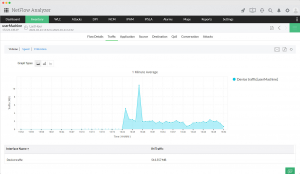Businesses adopting new technologies are looking for a digital transition that assures streamlined performance upgrades while cutting costs. Servers, an important endpoint of the network, have a great influence on both aspects. Given its significance, proactively monitoring server traffic trends, bottlenecks, and optimizing the network to lessen outages or downtime is indispensable. However, monitoring without powerful strategies and tools that fulfill your business objectives is a lost cause.
In this blog, we’ll look at some best practices of server traffic monitoring for a secure and reliable network, and NetFlow Analyzer’s edge in real-time server traffic monitoring for your dynamic environments.
Best practices for server traffic monitoring
Server traffic monitoring involves monitoring, tracking and managing the bandwidth usage of servers, to ensure that there is enough bandwidth for business purposes, and less security threats that start from bad actors. By monitoring server traffic, you can explore the context of your network’s interactions and enhance your monitoring process to tackle important cases. Some other benefits include:
- Issue resolution: Monitoring traffic helps you find slowness issues and where exactly those issues came from. Therefore, it helps troubleshoot incidents faster and protect the server from facing the same issue in the future.
- Resource allocation: Determining if the users are overusing or underusing the server’s bandwidth and if they work with your business objectives. This can help you evaluate your servers’ capacity and allocate bandwidth when and if needed.
- Security enhancement: Tracking the server’s traffic patterns and users can help verify if the network is being used for legitimate purposes or if it is being intruded by malicious traffic.
The benefits of server traffic monitoring can be fully leveraged when the monitoring tool and best strategies are tailored for your infrastructure’s requirements. Monitoring server traffic gives an understanding of your network’s behavior and capability, and helps you take performance and security measures. Let’s look at some strategies that could make a difference in your monitoring:
Establish baseline behavior: Defining how your servers should utilize the bandwidth and the expected quality can outline the user experience of your network. By configuring different levels of attention, you can prioritize these issues and make informed decisions as and when they occur.
Simplified monitoring: Correlating the data from different nodes of your server just to find one loophole or blind spot can make your monitoring challenging and sometimes empty-handed. You can customize a network traffic monitoring tool‘s dashboard to summarize the server traffic coming from different sources based on requirements, and find the node causing bandwidth strain.
Generating reports: Calculating and analyzing server traffic trends will give you a projection of how performance has been maintained or if there are gaps that could be fixed with prioritizing traffic or applications usage. By generating traffic reports based on requirements, you can also strategize your resource allocation process.
Segmenting endpoints: Segmenting the servers based on the nature of their functionalities or other attributes, such as location, could make a huge difference to your monitoring. You can create a small subset from your server pool to understand the bandwidth utilization from each department or particular branch and manage or restrict usage effectively.
Establishing fool-proof traffic monitoring with NetFlow Analyzer
Executing strategies requires a server traffic monitor that can integrate well with your existing infrastructure and scale when the organization grows in size. NetFlow Analyzer was specifically developed from the ground up to tackle challenges in monitoring complex IT infrastructure performance, and now enables you to oversee server traffic effectively.
ManageEngine NetFlow Analyzer is a comprehensive network traffic monitoring solution that provides visibility into your organization‘s associated devices and their utilization. NetFlow Generator, a configurable function of the Network Packet Sensor agent, collects the data packets coming from your servers, and translates them into NetFlow packets.

- Get down to every traffic source: NetFlow Generator helps you find server traffic by each entity, such as applications, protocols, and conversations.
- Find traffic spikes and their context: Analyze traffic patterns and detect if traffic spikes are suspicious and harmful to your servers with behavior anomaly detection.
- Identify the root cause with deep packet inspection (DPI): NetFlow Analyzer’s DPI finds the faulty side of any performance or congestion issue with raw data reports, and application and network response time data.
- Capacity planning and bandwidth usage forecasting: Our server traffic monitoring software assists you in getting data of your top application’s usage and forecast how your server’s capacity to handle traffic could be in the future.
Wrapping up
A business’s posture can be majorly influenced by its network. Servers are exigent to change a network’s reliability and security, which means your strategies, including the tool to monitor server traffic should be compatible with your environment. By opting for a server traffic monitoring tool like NetFlow Analyzer, you can achieve your business bottom-line with expected easy navigation, scalability and flexibility capabilities.
Take a free tour into our product with a 30-day, free trial
Alternatively, contact our support team for a personalized demo, today!